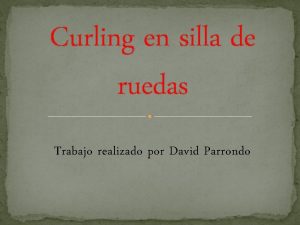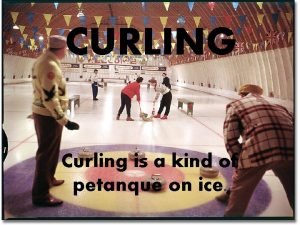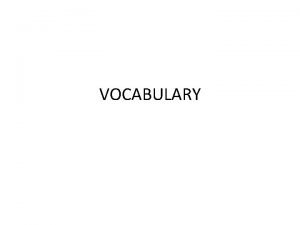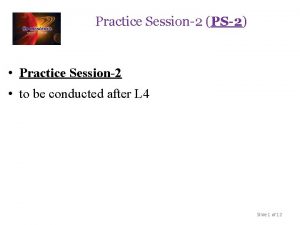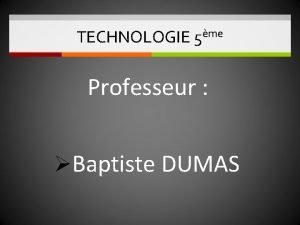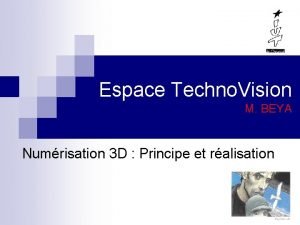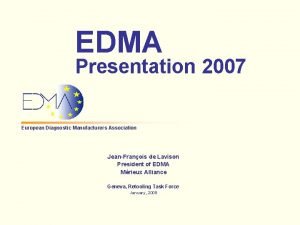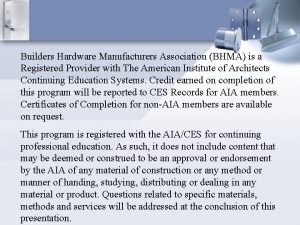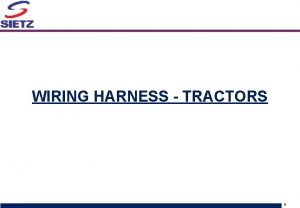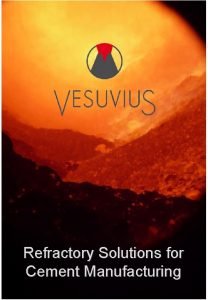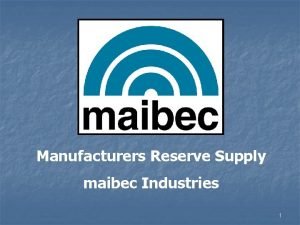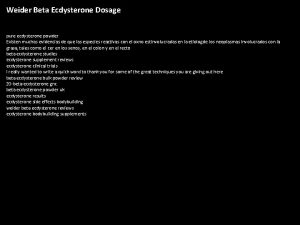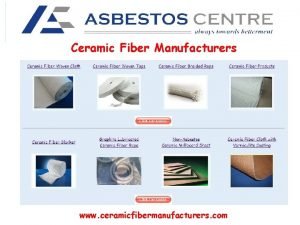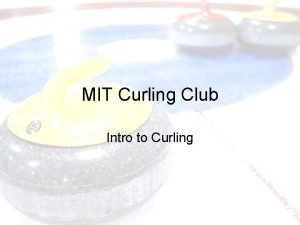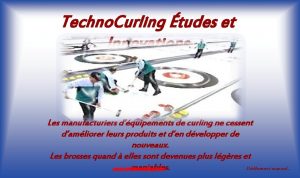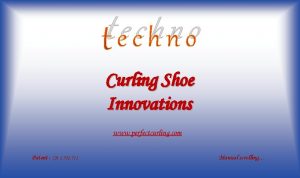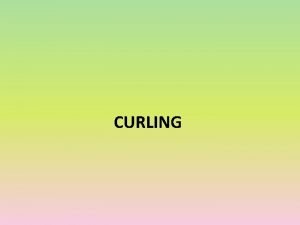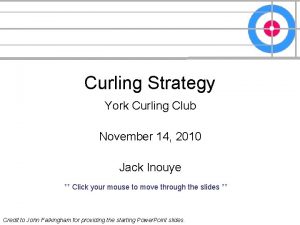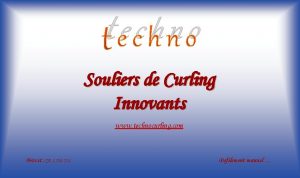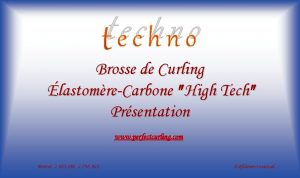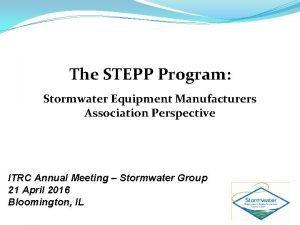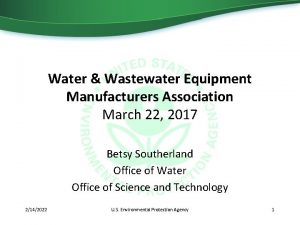Techno Curling Studies and Innovations Curling equipment manufacturers












































- Slides: 44

Techno. Curling Studies and Innovations Curling equipment manufacturers continually improve their products and develop new ones. The brushes have become lighter and easier to use. www. perfectcurling. com Manual scrolling…

History Some of us remember the good old straw brooms from before the 1980’s and how it was hard to brush with them. During those years, brushes were made from horsehair or hoghair more effective on frosty ice. The early 90’s saw the arrival of brushes with more or less dense foam, covered with synthetic fabric such as nylon.

Yesterday The straw broom is rarely used today except to wipe the underside of the stone and to accompany the slide. Animal hair brushes are also used less frequently. One reason for the reduced use of these types of brushes is that they lose strands of material that negatively affect the path of the stone.

Today The brushes used today are generally oval or rectangular in shape with pillowed soles covered with synthetic fabric. Broomsticks are either solidly attached or connected with a universal joint to the brush. *** The flexible fabric sole is the target of our concern. ***

Critical Analysis A fabric sole absorbs water. It absorbs even more as frosted ice accumulates. Being wet, it increases difficulties rather than reducing them. It must be replaced to regain efficiency. With brushing, too much heat is generated and a fabric sole saturates the melting droplets and gradually lowers them. The sole being flexible, sinks, and all droplets surfaces are reached instead of only their heads. It does not level them properly but crushes and therefore reduces all of them. Working in this way to the base of the droplets, the sole becomes encrusted with grease and dirt, is very difficult to clean and therefore its effectiveness is reduced even more.

Other remarks… A fabric sole is costly and must be replaced frequently. It does not provide uniform pressure on the surface of the ice because its brush head, which is made of plastic, is not rigid enough. If the fabric is fixed on a flat base and lightly padded, it deteriorates more rapidly. Often made in nylon thread which is hydrophilic itself, this fabric through wear and tear loses fibres that remain prisoners of the ice. This causes a certain degree of wear on the bearing surface of the stones. The fabric sole requires a great amount of energy and effort as its contact surface increases.

Efficiency A study of physical phenomena was conducted to: Be aware of environmental conditions: ice, humidity, temperature, etc…; determine how to preserve the best ice conditions throughout the game; determine efficient sweeping on the required surface and also on the top of the droplets which are not at the same height; determine how to bring with better sweeping a levelling of the surface of the ice; minimize the sweeping energy required to obtain effective results; find less aggressive sweeping and to provide cleaner conditions for the ice.

Hardness of the Ice is solid water in mineral crystallographic form brittle and breakable. It is vitreous and transparent. It is fragile and not resistant to impact. It melts in the hand. On " Mohs" hardness scale the ice value is 1. 5 like lead and aluminum. The ice has been used for a very long time for slide sports. Considering its formation, the ice is a rock. Imagine a curling rock aquaplaning on a flat finished rock covered with a lubricating water film! Should it have the same curl as on ice ?

Why is Ice Slippery ? Ice molecules located on the surface of an curling ice are less "trapped" than those more in depth because they are not surrounded on all sides by other molecules. Being more free they naturally create a micro -layer that is not quite water and not quite ice. The interface between the air and the ice therefore provides a layer of water which does not need any more energy for the sliding of a 20 kg. curling stone or a 5 kg. object.

Surfusion Under certain conditions, water may be cooled a number of degrees below the usual freezing point and still remain liquid, but freezes as soon as it contacts solid particles, micro-fibres or other impurities in the ice. However the presence of gas dissolved in water pebble spray contributes to maintaining this liquid state at a temperature below 0°C. The presence of dissolved gas in the water creates a molecular agitation with the same effect that heat has. Ice at -4, 5°C is said to be " hot ice ". That will be different at -30°C.

Sublimation and Condensation Atmospheric air that we breathe space of curling, the air pulls the ice surface, i. e. the of water (ice) in needs moisture to exist. In an enclosed moisture in part by sublimation on direct passage of the solid state its gaseous state (moisture). This is why it is important to remove moisture constantly in order to maintain an ideal condition of relative humidity for the good behaviour of the ice. This phenomenon will smooth out the bumpy ice surface lowering the pebble little by little. Condensation is the opposite effect, there is formation of frost on the ice surface.

Frost When temperature and humidity conditions are met to freeze this moisture in the air at the level of the ice, a layer of crystals attaches to the ice surface. This occurs often in the morning or before the game in the enclosure of curling. A brief reheating may contain this phenomenon which slows down the sliding of the stone until the temperature increases with the arrival of the players on the ice.

The Frost Point This is the point of condensation, that is, the saturation temperature of the moisture that the air contains. A frost point of -4°C means that if the ambient air near the surface of the ice reaches this temperature, the excess of moisture that the air contains condenses. If the conditions of temperature and humidity in the enclosure are well adjusted, the crystals formed on the heads of the pebble make faster ice. The opposite occurs if the temperature and humidity levels are poorly controlled; there is accumulation of frost and the ice becomes less rapid.

Inertia The speed of a curling stone in motion (the intensity and direction or rotation) cannot be changed unless more force is used. A stone on a pebbly surface will not continue its path on an ongoing basis if, and only if, one or more external forces (friction, brushing) requires it to decrease or increase its speed or change its direction or rotation.

The Tribology is the science and technology of friction, lubrication and wear. Applied to curling Friction: Fusion: Erosion: the force that resists the friction of the brush on the icy surface. the passage from a solid state to a liquid state due to the friction of the brush on the heads of the pebble. the levelling of the heads of the pebble caused by the friction of the stone or the brush.

Friction occurs between two objects that touch each other by moving one over the other. The surface of these objects is sometimes covered with microscopic burrs that cling and cause a slower speed, sometimes changes of direction, hops, heat and noise (curling moving stone). The amount of friction due to brushing depends on the nature of the surfaces in contact, on the surface of contact and the intensity of the force pressing the two objects against each other. On the ice, this is accompanied by heat causing the melting and erosion of the burrs.

Fusion (stone) With the hypothesis that half the droplet heads are of the same height, there would be approximately 10 to 12 heads that would bear a 20 kg. stone. Each droplet would therefore support about 2 kg. This generates enough heat due to friction of the moving stone to soften and flatten the highest heads.

Fusion (brush) With the hypothesis that half of the droplet heads were of the same height, there would be approximately 20 heads in contact with the sole of the brush, provided that it is flat. Compared to the stone, it is therefore a force of 40 kg. that is required on the brush so that 2 kg. are applied on each droplet head, folding them down a bit. Hence the importance of the speed of brushing to warm up the heads and level them enough in the path of the stone.

Erosion Resistance to the friction between the surfaces of stone and ice is less if enough droplet heads are levelled. This is the reason for the slashing of the droplets before a game. The stone itself levels off the droplets, and its underside should be cleaned before each delivery. Brushing generates heat and reduces friction resistance by levelling of the droplet heads in the path of the stone, allowing it to maintain its momentum longer and thus moderate its curve.

Pressure With solids such as ice, melting reduces its volume and pressure applied on it reduces its fusion temperature. The pressure must be approximately 1500 psi. to lower it by 1°C. It is therefore very important to apply pressure in a quick back and forth movement of the brush on the highest heads of the pebble to bring them level with the others. This reduces the amount of friction on the bearing surface of the stone. When a sufficient number of heads are levelled the stone slides more accurately.

Refreezing of the ice When the droplet heads are not subject to the pressure of a curling stone in motion that liquefies them somewhat, they solidify immediately leaving them levelled for some time, until frost, evaporation or sublimation continue their effect, and change their height. This is the same phenomenon of pressure and refreezing that facilitates the sliding shoe. Ice spikes that support the sole melt under pressure, lubricate it and then immediately after passing, the melted water refreezes.

Sliding of the stone The delivery of the stone causes its mass to smooth out and lower the highest droplets. The front part of the crown under the stone is raised somewhat by this action and produces a thin liquid film in its rotation between it and the tops of the droplet heads. The increase in the amount of friction at the back of the stone is caused by the viscosity of the resistive water lubricant film. (Imagine an oil !)

Illustration of the phenomenon of the curl of a stone on a pebbled icy surface with a clockwise rotation. On a dry surface it would be otherwise. A stone curls more as its speed decreases because the forces opposed to the friction under its crown are at an angle perpendicular to the changing axis of its path. This is " rotation translation" i. e. two properties that exist at the same time. The forces opposed to the friction drag the stone to the right in clockwise release rotation and to the left in the opposite rotation.

Conclusion To smooth or polish any surface, the rough surface must be levelled to an equal height. It is not unlike a professional body repair man using ultra fine water-lubricated sandpaper on a long flat block smoothing and finishing the surface. To do this with sandpaper placed on the hand would not flatten it equally. It is evident that to maintain the proper movement of a stone on pebbled ice, it is important to bring to the same level as many of the rough and uneven droplet heads as possible in order for the stone to slide smoothly and without hops. The way to do this is to rub the heads using a rigid and flat surface with recesses to accommodate frost and dirt. Then the film of water becomes the lubricant.

Research and Development led to a newly designed curling brush.


The Result A brush with an articulate broomstick that has been specially designed to level the highest pebble heads with quick back and forth movement and appropriate pressure. A flat synthetic elastomer brush sole that is non-absorbent, is extremely efficient whether ice is frosted or not and is easy to clean between each use. A sole with a solid patterned friction surface that thermally provides by multi-shocks equal topping of the droplet heads. A brush whose effectiveness is optimized by a combination of effort and accuracy.

The Shell Made of carbon fibre from a range of extremely resistant composites, it is very light. This is two essential qualities for the brush head. The shell is shaped to prevent flexion forces imposed by the pressure applied to it. This shell has a complete thermal and noise insulation. The base guarantees good support for a flat rigid sole with a grooved pattern. The shell also allows a larger angulation of the broomstick because of its shape. This shape also allows the attachment of the connector.

The Shape It is generally recognized and accepted that a rectangular shape is best suited for a curling brush. Designed to brush at all angles the sole is 22 cm. in length by 8 cm. wide. With a quick back and forth movement and a range of 28 cm. , the sole stays in the diameter length of the bearing crown of the stone. This is just where it is needed to trap frost and dirt in the grooves without unnecessarily moving to a wider portion of the path.

The Sole Polymer elastomer has been carefully selected for the manufacture of a sustainable and effective sole. This material combines the essential qualities of hardness, rigidity and resistance to abrasion and absorption. The perfect amount of friction was achieved by choosing its hardness and its surface design in a pattern which causes thermal multi-shocks on the higher droplet heads. It is almost rectangular in shape to maximize friction. The sides are straighten to support the slide. And it also traps dirt and frost in its grooves.

The Connector The connection of the broomstick to the head of the brush has a connector with the following features: To receive, retain and protect the end of the handle ; a universal joint; a generator of friction in its articulation and between its convex end and the concave cavity in the shell ; the transmission of pressure to the brush head. Patent: 2, 746, 925

The Broomstick A broomstick designed and well-balanced supports the characteristics of this carbon ultra-light brush/broomstick. Its surface provides, with or without the use of gloves, a solid grip considering the angle of brushing. The lower end, which is inserted in a reinforced ring, allows shock absorption to protect the joints of the player. Our new " Timer Buzzer " can be attached to it.

Weight The impulse of a brush is relative to the weight of the brush, the weight applied to the brush, the duration and the resistance of the movement. The ideal weight of a curling brush is difficult to determine. The " feeling " is a good guide. A weight of approximately 450 grams appears to be ideal. A carbon rigid brush is much lighter and therefore requires less effort and is more accurate.

The Colours The colours of the brush convey its character. The sole yellow is bright and clearly visible from a distance. Red-orange is a very bright and pleasing colour. Both colours clearly show the dirt to be removed. The head is a grey black natural carbon fibre. The connector is a black colour which means reliability and strength. The broomstick colours harmonize with the head and sole.

The Use According to the circumstances, brushing can be done in any rotation of the brush. It is preferable to leave the brush near the ice to maximize the brushing attack speed. A good brushing technique is to be as close as possible to the path of the stone so that the broomstick is at an angle of approximately 50° to 60°. This position allows the brush by its broomstick to provide the maximum compression weight needed.

Illustration 1 Distance from the back line to the 2 ° T line= 36. 58 m. Speed ice 28 sec. from the back line to the 2 ° T line. Clic here The coefficient of friction = 3, 8 N. Speed of the stone of 19 kg at starting ? V² = 2 x 3 X 36. 58 m 8 N / 19 kg = 14, 63² V = 3. 825 m/sec. 1° Hog lines 2° Speed in meters per second Deliver 3. 825 3. 5 3 2. 5 2 1. 5 0 0 3. 8 Time in seconds for a draw 18 28 sec. The brushers brush alternatly and perpendicularly to the delivery axis, at a speed which ensures the achievement of the entire surface of the path taken by the stone. On the " Mohs " hardness scale 1. 5 ice is close to that of aluminum. So there's advantage to brush the top of the highest droplets for level them, maximizing stone sliding conditions. Only a flat and rigid brush sole can ensure a flatness of the surface of the ice. 36

Illustration 2 Distance from the back line to the 2 ° T line= 36. 58 m. Speed ice 28 sec. from the back line to the 2 ° T line. Clic here The coefficient of friction = 3, 8 N. Speed of the stone of 19 kg at starting ? V² = 2 x 3 X 36. 58 m 8 N / 19 kg = 14, 63² V = 3. 825 m/sec. 1° Hog lines 2° Speed in meters per second Deliver 3. 825 3. 5 3 2. 5 2 1. 5 0 0 3. 8 Time in seconds for a draw 18 28 sec. One brusher brush more or less perpendicular to the delivery axis while the other brush lengthwise almost in line with the delivery axis. With this method the entire surface in the path of the stone is reached for sure. Many players is at an angle of around 45 °, which is great. All the brushes can cast off the frosted droplets heads, but a flat, rigid sole brush levels more and with much less effort, allowing the stone to slip much better and further. 37

The Benefits More efficient and better results. Components of the brush are composite materials and are made with precision. Respect for the ice with a clean sole. Brushing is totally directional. Very easy to clean and dry. Durable sole has a long life. Grooved sole surface is adjusted. Light and durable carbon fibre broomstick. Lightweight and available in many colours. Rapidly get into the habit of using it and quickly desire to adopt it. Equalize the pebble but also the capacity of the brushers. Adds to the effectiveness of the brushing by a third brusher. Advantageous for curlers of all ages.

The Innovation The method of reverse engineering provides an analysis of existing brushes, the needs of users, the problems and possible improvements. This led to the design of this curling brush for a new generation. Patent: CA 2, 665, 086

This presentation is a summary of a study that brought us to the innovative concept of this new curling brush. We will appreciate your comments and your interest in these innovative products. info@technocurling. com

In the same steps Curling shoes, soles, materials and safety improvements have been made and are patented innovation. Similarly, new Delivery Sticks , a Timer Buzzer and a Handle Strap have been made. Further improvements to the curling player’s personal equipment are under study and development and the focus is on increased comfort and safety in the activity of this sport.

Designer Having a career in engineering at Laval University and at University of Quebec at Trois-Rivières, Gaston Gagné reached retirement and engaged in his favourite sport - curling. Working with icemen, he introduced a study on the optimum conditions to be achieved within the walls of his curling centre. Focusing on the importance of cleanliness and maintenance of the quality of the ice, the physical capabilities of the players and the quality of the equipment available, he began the study of improved curling products that would be better suited to a curler’s needs. This led to the design of unique and innovative curling products that provide improved and accurate results.

techno « techno » is used to describe the structural nature of our new curling equipment and thoroughness in our work. Hundreds of hours of research and development have resulted in a line of products that will enhance and improve the sport of Curling. Our Innovations Curling Brush Connector Brush Handle Timer Buzzer Curling Shoes Curling Sticks Handle Strap

Mission Statement: To improve the performance and satisfaction of all curlers with innovative and uniquely designed equipment. Share the joy with your own Techno. Curling Innovations! www. technocurling. com Gaston Gagné 2017 Pier & Rog Carlton
 Curling en silla de ruedas
Curling en silla de ruedas Curling analytics
Curling analytics Petanque curling
Petanque curling Energy transformation song
Energy transformation song The narrator says she got out her curling irons
The narrator says she got out her curling irons Magyar curling
Magyar curling Techno-pedagogy
Techno-pedagogy Chicken techno
Chicken techno Techno root words
Techno root words Techno.rambeau.xyz
Techno.rambeau.xyz Ps2 practice management
Ps2 practice management Techno structural interventions
Techno structural interventions Techno timer
Techno timer Techno canada inc
Techno canada inc Heat exchange
Heat exchange Szivk
Szivk Techno dumas
Techno dumas Techno
Techno Techno structural interventions
Techno structural interventions Techno gender
Techno gender Techno vision
Techno vision Techno
Techno Kata techno
Kata techno Techno weld consultants
Techno weld consultants Paradigm shift from women studies to gender studies
Paradigm shift from women studies to gender studies Type ac cable
Type ac cable Allergen checklist for food suppliers and manufacturers
Allergen checklist for food suppliers and manufacturers Muslim innovations and adaptations answers
Muslim innovations and adaptations answers Muslim innovations and adaptations
Muslim innovations and adaptations Marketing of high technology products and innovations
Marketing of high technology products and innovations Coast guard manufacturers identification code
Coast guard manufacturers identification code Gyroplane manufacturers
Gyroplane manufacturers European diagnostic manufacturers association
European diagnostic manufacturers association Builders hardware manufacturers association
Builders hardware manufacturers association Sai paradise machine tools
Sai paradise machine tools Manufacturers seeking distributors
Manufacturers seeking distributors Surshot
Surshot Plastics machinery manufacturers association of india
Plastics machinery manufacturers association of india Indian pharma association
Indian pharma association Manufacturers reserve supply
Manufacturers reserve supply Car bumper height
Car bumper height Ecdysterone reviews
Ecdysterone reviews Loos seismic cable manufacturers
Loos seismic cable manufacturers Server manufacturers
Server manufacturers Ceramic fiber manufacturers
Ceramic fiber manufacturers
